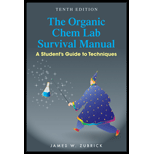
Interpretation:
Select the MSDS for 2-naphthol one from Thermo Fisher and another from J. T. Baker/Mallinckrodt and speculate them as one says this compound will cause death on inhalation, and the other, well, not so much is to be explained and also google the MSDS for sugar.
Concept Introduction:
An
If a person taking organic lab, he/she will stick to hazard data and references in the other handbooks and will be knowledgeable enough.
“A material safety data sheet(MSDS) reflects the hazards of working with the material in an occupational fashion. For example, a MSDS for paint is not highly pertinent to someone who uses a can of paint once a year, but is extremely important to someone who does this in a confined space 40 hours a week.”
Want to see the full answer?
Check out a sample textbook solution
Chapter 1 Solutions
The Organic Chem Lab Survival Manual: A Student's Guide to Techniques
- Of Aspirin, ethanol, acetaminophen, ethyl acetate, hexane, and water which could go undetected during HPLC analysis, but could result in a lower than expected melting point, why are they not detected by HPLC analysis?arrow_forwardBased on the readings and lecture on emulsions, and the procedures for this lab answer the following question. What is the dispersed phase in the simple vinaigrette? Air Oil Water Eggarrow_forwardEach of the student statements below is wrong. Explain why they are not correct. (a) All my compound dissolved right away in the small amount of solvent I added at room temperature, and I didn’t need to heat it at all. This means I’m going to get lots of pure compound out. (b) I did a recrystallization of naphthalene and my percent recovery was very high (99%), so I must have pure product. (c) When you’ve dissolved all your compound in hot solvent, and you’re in a hurry, it’s ok to just place it straight into the ice bath.arrow_forward
- please answer hurry up ..... What kind of “cation and anion exchanger resins” can be used in the columns of an ion chromatography instrument. Draw chemical structure of the ion exchanger group for each type.arrow_forwardWhat can you say about how Norbixin and Beta Carotene will behave in your experiment just by looking at the circled differences in their structures? ( the experiment was thin Layer Chromatography. finding compounds in spinach juice using their polarity and retention factor, Rf= distance traveled by the compound / distance traveled by the solvent). (Please do not copy and past some idea from other websites. I can do that myself) undefinedarrow_forwardIn this experiment, you will be performing TLC on your 'crude' and 'recrystallized' biphenyl samples. How many spots would you expect to see in each lane? Explain your answer. 2. If you perform pipette (column) chromatography on the mixture containing biphenyl and organic dye, which compound would you expect to elute from the column last. Explain your answer.arrow_forward
- Distances traveled by the solvent is 3.2 First spot ( fluorene) is 2.5 Second spot distance equals 1.4 How can we calculate the Rf for the Chromatography experiment?arrow_forwardSEE PHOTO: Effectiveness of separation. Based on the TLC analysis, did the isolated benzoic acidappear pure relative to the starting mixture? Did the isolated naphthalene look pure?How could the purity of the isolated materials be improved? In the picture: Aq- is Benzoic acid O- is Naphthalene both- is both Benzoic acid and Naphthalenearrow_forwardFollowing the Kjeldahl procedure, calculate the % protein content of a flour sample by considering the following: Vol HCL (0.1 N) for blank = 0.2 mL Vol HCl for sample = 16 mL Wt of sample = 1.0872 g N conversion factor = 5.7 ...i will surely upvote...please answer asaparrow_forward
- This is for the dehydration of methylcyclohexanols experiment using phosphoric acid i just need the peaks of this GC to be chemically identified please. Thank you. And also please explain how you did it. thank youarrow_forwardWhat are emulsions? Why do they form during extractions? How is the formation of an emulsion minimized?arrow_forwardWhich statement is true? Statement 1: In a paper chromatography that uses a cellulose-based filter paper as stationary phase and hexane as the mobile phase, non-polar compounds are expected to have higher Rf values than that of polar compounds. Statement 2: In paper chromatography, the highly adsorbed compounds tend to outdistance the weakly adsorbed ones.arrow_forward
 ChemistryChemistryISBN:9781305957404Author:Steven S. Zumdahl, Susan A. Zumdahl, Donald J. DeCostePublisher:Cengage Learning
ChemistryChemistryISBN:9781305957404Author:Steven S. Zumdahl, Susan A. Zumdahl, Donald J. DeCostePublisher:Cengage Learning ChemistryChemistryISBN:9781259911156Author:Raymond Chang Dr., Jason Overby ProfessorPublisher:McGraw-Hill Education
ChemistryChemistryISBN:9781259911156Author:Raymond Chang Dr., Jason Overby ProfessorPublisher:McGraw-Hill Education Principles of Instrumental AnalysisChemistryISBN:9781305577213Author:Douglas A. Skoog, F. James Holler, Stanley R. CrouchPublisher:Cengage Learning
Principles of Instrumental AnalysisChemistryISBN:9781305577213Author:Douglas A. Skoog, F. James Holler, Stanley R. CrouchPublisher:Cengage Learning Organic ChemistryChemistryISBN:9780078021558Author:Janice Gorzynski Smith Dr.Publisher:McGraw-Hill Education
Organic ChemistryChemistryISBN:9780078021558Author:Janice Gorzynski Smith Dr.Publisher:McGraw-Hill Education Chemistry: Principles and ReactionsChemistryISBN:9781305079373Author:William L. Masterton, Cecile N. HurleyPublisher:Cengage Learning
Chemistry: Principles and ReactionsChemistryISBN:9781305079373Author:William L. Masterton, Cecile N. HurleyPublisher:Cengage Learning Elementary Principles of Chemical Processes, Bind...ChemistryISBN:9781118431221Author:Richard M. Felder, Ronald W. Rousseau, Lisa G. BullardPublisher:WILEY
Elementary Principles of Chemical Processes, Bind...ChemistryISBN:9781118431221Author:Richard M. Felder, Ronald W. Rousseau, Lisa G. BullardPublisher:WILEY





